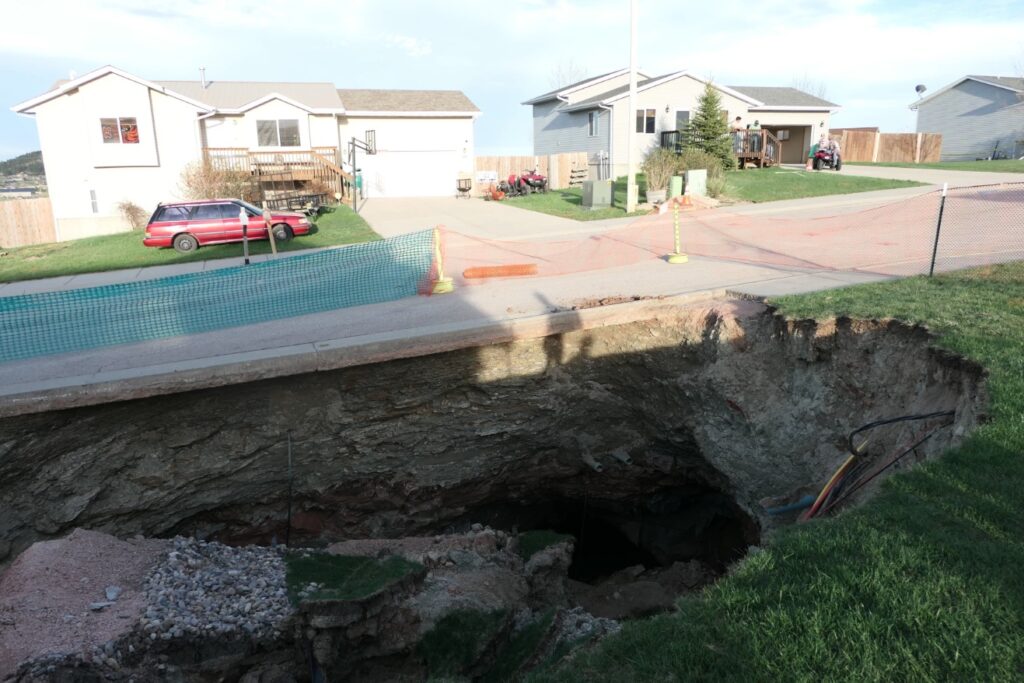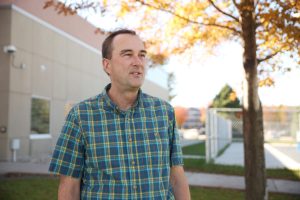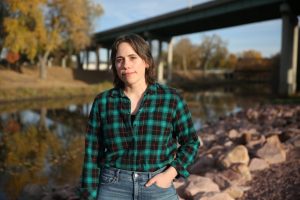A spring 2020 view of a sinkhole in Black Hawk that opened near homes built atop a former gypsum mine. (Courtesy of Dan Austin)
Landowners forced from their homes five years ago by a sinkhole asked the South Dakota Supreme Court on Wednesday to hold the state accountable.
The Hideaway Hills development in Black Hawk was built atop a former gypsum mine first used more than a century ago on the eastern edge of the Black Hills. For more than 50 years, that work involved a network of underground tunnels. The mine was dormant until the mid-1980s, when the state purchased it to mine gypsum on the land’s surface for use in a Rapid City cement plant the state owned at the time.
The state reclaimed about 16 acres of mined land, then reseeded it for use as rangeland before selling it in 1994. The man who bought it later sold it to the developers who turned it into Hideaway Hills in the early 2000s. The state maintained subsurface mineral rights to the land in the sale.
South Dakota Supreme Court rules against neighbors in now-moot prison site dispute
Homeowners first reported cracking in their homes’ foundations in 2008, about three years after the Meade County development welcomed its first residents. Twelve years later, a sinkhole yawned open near a cluster of homes, forcing evacuations and spawning a lawsuit.
The plaintiffs, representing 164 properties, say the state put them at risk when it failed to properly backfill the land. They also claim the state reopened tunnels in search of more gypsum, a claim the state denies.
A lower court ruled against the families. The judge agreed with the state, which argued it has immunity from “tort” lawsuits that seek to assign liability and collect monetary damages.
The landowners appealed to the state Supreme Court. They say their claim is not a “tort,” but is rather about a “taking” of their land that was akin to eminent domain. Their “inverse condemnation” claim says the state robbed them of their full property rights by failing to backfill the mine correctly and using the mined material in a cement plant whose proceeds were used for a public purpose.
Proceeds from the 2001 sale of the cement plant were used to establish a trust whose returns now help fund state government.
Landowners: State stole property rights
Arguments in the case took place Wednesday morning at the University of South Dakota Knudson School of Law in Vermillion.
High court rules in favor of victim, but says Marsy’s Law is not absolute
Matthew Hughes, one of the landowners’ lawyers, said the state had a duty to reclaim and backfill its mined areas with material that would hold up as time passed, rather than with gypsum. That material sank in over time, he said.
“That backfill is under every place that the state mined,” Hughes said, and “all the problems” the homeowners have are related to the reclamation.
What the homebuilders or real estate agents may or may not have said to homebuyers about the land is immaterial, he argued, because “the sole cause of the subsidence and the collapse is the state’s use of problematic backfill.”
Because the surface land was sold in the public interest, he said, and because the state retained the mining rights to the area beneath it, the state owes the homeowners for their losses.
“That reclamation was undertaken for the purpose of selling the surface for money,” Hughes said.
State: Buyer responsible for issues
Terra Larson, an attorney representing the state, disputed that the state’s actions caused the sinkhole to appear. But she also said it doesn’t matter.
The landowners have a tort claim, she said, and the state’s immune to those.
The claim of “taking” by inverse condemnation doesn’t fit, she said. The state constitution says that private land can’t be taken for a public purpose without “just compensation.”
No one took land from the current landowners without just compensation, Larson said.
“All of the damage that occurred here occurred when the state owned this property,” Larson said, referring to the reclamation.
“Then, when it sold that property, it sold it for approximately $50,000 less than it had purchased the property for, to people who absolutely knew that the state had mined it for gypsum,” Larson said.
Justice Mark Salter wanted to know about the “contemporaneous” aspect of the landowners’ claim. Does the state have a duty to landowners because it kept the mineral rights to the area below the surface?
“There’s a present day resonance to this,” Salter said.
The land’s 1994 buyers knew about the underground tunnels, Larson said, and the agents who later sold the land “fraudulently concealed” the issue. When a new owner discovers a danger on a property and doesn’t disclose it, Larson said, “the responsibility has shifted to that third party” for lawsuits by subsequent property owners.
Matthew Leerberg, another attorney for the homeowners, said in his rebuttal the state can’t both maintain the right to mine the land far beneath the homes and escape its responsibility to those who built them.
“At some point, hopefully we will be before a jury, and we will get to show that these clients are suffering, that they can’t live in their homes anymore, and that it’s the state’s actions, both in the past and the present, that have caused that,” Leerberg said.
The court will issue a ruling on the Hideaway Hills case at a later date.
Stay updated on developing stories like this one: Sign up for our free newsletter.





